You can create simple aromatherapy perfumes at home using essential oils and basic supplies like glass bottles, droppers, and carrier oils. Start with calming lavender, uplifting citrus, or stress-reducing bergamot oils mixed at a 2% dilution rate (12 drops per ounce of carrier oil). Combine your chosen oils in a roll-on bottle with jojoba or sweet almond oil as your base. Let your blend mature for 24 hours for ideal results. Our detailed recipes and techniques will help you craft your perfect signature scent.
Essential Oils and Their Therapeutic Properties
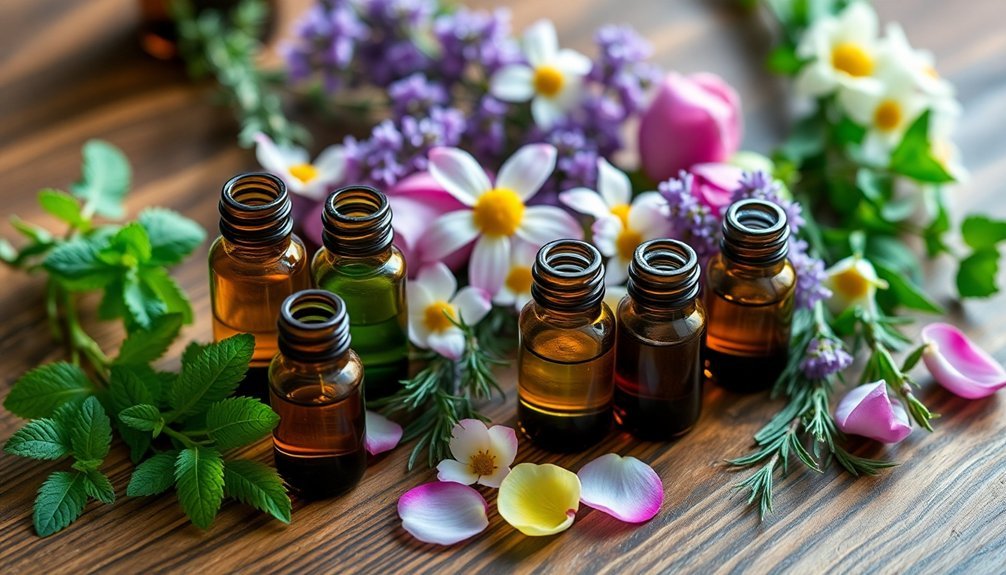
The versatile world of essential oils offers a natural approach to wellness through their therapeutic properties.
You'll find that lavender and bergamot oils excel at reducing stress and improving sleep quality, while tea tree and eucalyptus oils provide powerful antimicrobial benefits.
When you're seeking digestive support or pain relief, peppermint oil can ease stomach discomfort and boost energy levels. Creating effective blends requires dilution with carrier oils to prevent skin irritation.
For emotional balance, orange oil has proven anxiety-reducing effects, and lemongrass oil helps combat depression.
If you're dealing with inflammation or respiratory issues, frankincense oil might be your best choice.
Many of these oils serve multiple purposes – for instance, eucalyptus not only fights microbes but also relieves pain and clears nasal passages.
Understanding these properties helps you create personalized aromatherapy blends that target your specific needs.
Basic Equipment Needed for DIY Perfume Making
Creating your own aromatherapy perfumes starts with assembling essential equipment and tools.
You'll need various glass containers, including spray bottles with non-clogging nozzles, rollerball bottles, and mixing vessels for your base ingredients. Don't forget solid perfume containers if you're planning to make balm-style fragrances. A curated fragrance set comes in handy for beginners just starting their perfume-making journey.
For precise measurements, you'll want pipettes and droppers to handle your oils carefully.
Keep transfer funnels handy for spill-free pouring, and use scent testing strips to evaluate your creations. Stock up on perfumer's alcohol or natural alternatives like non-GMO spiced rum as your base. Essential carrier oils such as jojoba or fractionated coconut oil are also vital.
Track your creative process with recipe cards and labels for your finished perfumes.
Remember to wear gloves and keep alcohol wipes ready for clean-up.
Understanding Top, Middle, and Base Notes
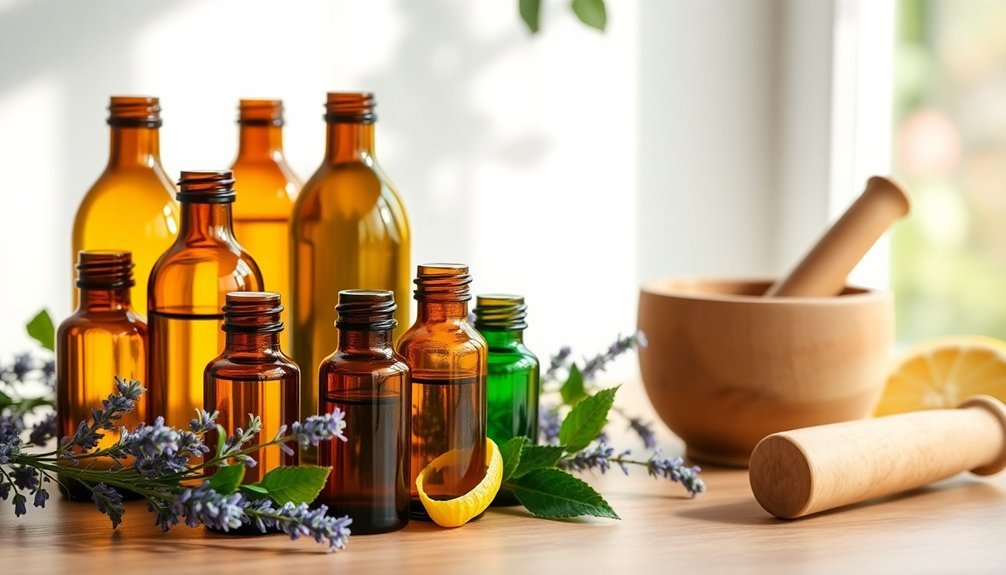
When crafting aromatherapy perfumes, you'll need to master the three distinct layers of fragrance notes that give your creation its unique character.
Top notes create your first impression but evaporate quickly, while middle notes form the heart of your perfume, lasting up to an hour. These middle notes are typically mellow and balancing in nature, providing a smooth transition between layers. Base notes provide the foundation, lingering for six hours or more.
For a well-balanced perfume, remember these essential ratios:
- Top notes: 20-40% (citrus, fresh, green)
- Middle notes: 50-75% (floral, herbal, spicy)
- Base notes: 5-10% (woody, musky, resinous)
- Blend drop by drop for refinement
You'll want to guarantee each layer flows smoothly into the next, creating a harmonious symphony of scents that evolves beautifully on your skin throughout the day.
Safety Guidelines for Handling Essential Oils
Safe handling of essential oils requires strict adherence to proper storage, dilution, and application methods.
Store your oils in a cool, well-ventilated area away from direct sunlight and heat sources. Keep them in a locked cabinet out of children's and pets' reach.
You'll need to dilute essential oils before skin application, using carrier agents like perfumer's alcohol or fractionated coconut oil.
Stick to dilution rates under 5% for adults and 2.5% for children. Always perform a patch test before using a new oil by applying a small amount to your forearm and waiting 24 hours.
If you experience irritation, discontinue use immediately. Don't apply oils to damaged skin or exceed 30-60 minutes when diffusing.
In case of accidental ingestion, contact poison control right away.
Creating a Calming Citrus Blend

You'll discover the art of creating calming citrus blends by pairing bright oils like bergamot and mandarin with warm, grounding notes such as sandalwood.
When selecting your essential oils, start with sweet orange as your base, then carefully add smaller amounts of sharper citrus oils like lime or lemon for balance.
To achieve the perfect blend, mix your chosen oils with appropriate carrier oils at a 2% dilution rate for adults, ensuring both safety and effectiveness.
Mix Citrus With Warmth
Creating a harmonious blend of citrus and warm spices offers a powerful combination for aromatherapy perfumes.
You'll find that citrus oils like lime, mandarin, and orange provide an uplifting base, while warm notes of cinnamon, clove, or star anise add depth and comfort to your blend.
For a balanced citrus-warmth perfume, try these essential oil combinations:
- Orange and cinnamon bark for an energizing, spicy aroma
- Bergamot and cardamom for a relaxing, grounding effect
- Mandarin and star anise for a sweet, calming blend
- Lime and clove bud for an invigorating, warming scent
You can use your blend in multiple ways: add 6-12 drops to a diffuser, create a room spray, or mix with a carrier oil for a soothing massage.
The combination will help boost mood, enhance focus, and create a welcoming atmosphere.
Choose Your Essential Oils
Building a calming citrus blend starts with selecting the right combination of aromatherapy oils. For a soothing foundation, consider mandarin essential oil, the sweetest and most calming of the citrus oils.
You'll find it particularly effective for evening use and promoting restful sleep.
Pair mandarin with sweet orange oil to enhance emotional balance and mental clarity while maintaining the calming effect.
If you're seeking additional therapeutic benefits, add bergamot for its mood-balancing properties and floral undertones, or petitgrain for its woody-citrus notes and stress-reducing qualities.
Remember to properly dilute your citrus oils, as many can cause photosensitivity.
When blending, start with small amounts and adjust according to your preferences, keeping in mind that each oil contributes its unique properties to the final aromatic composition.
Perfect Dilution and Blending
When crafting a calming citrus blend, proper dilution becomes the cornerstone of a successful aromatherapy perfume.
You'll want to use weight-to-weight measurements rather than drops to guarantee accuracy in your blending process.
For your citrus blend, consider these essential proportions:
- Orange and grapefruit as your primary base (50%)
- Lemon for brightening the blend (25%)
- Lime to add complexity (15%)
- A touch of spearmint for balance (10%)
Dilute your blend in perfumer's alcohol for the best scent evaluation, or choose a carrier oil if you're creating an oil-based perfume.
For most materials, start with a 10% dilution ratio – that's one part essential oil mixture to nine parts diluent.
If you're working with particularly strong oils, reduce the concentration to 1%.
Crafting a Romantic Floral Perfume
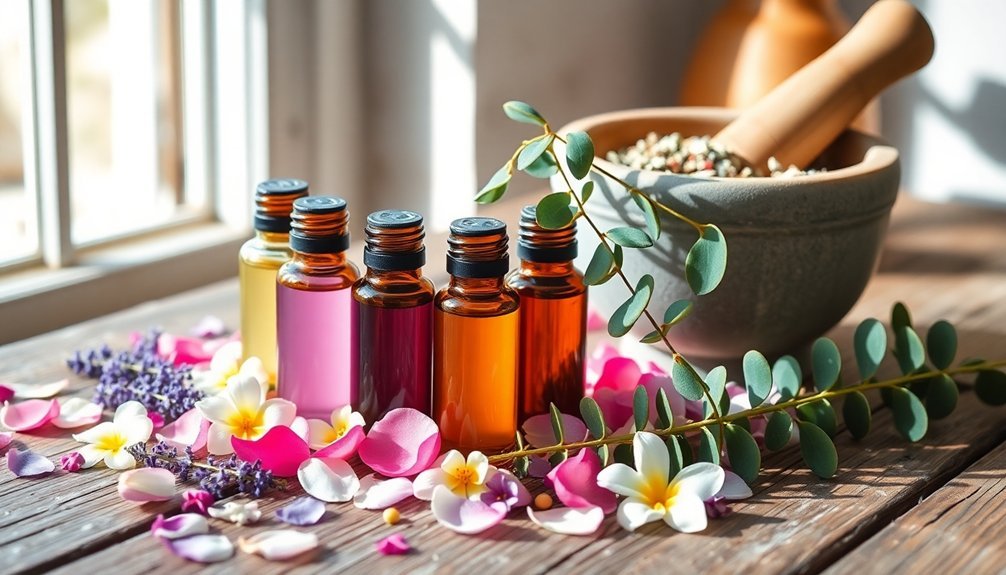
Dreaming of making your own romantic floral perfume? Start by selecting your top notes: combine mandarin and bergamot for brightness, then add a touch of pink peppercorn and crushed violet leaves for freshness.
For the heart, blend Rose Damascena with jasmine absolute – they're a perfect pair that creates an intimate, sensual core. Add small amounts of lavender and ylang ylang to enhance the romantic quality.
Ground your creation with lasting base notes by combining pure musk with sandalwood. You'll want to add a hint of vanilla for sweetness and frankincense for depth.
The key is layering these notes carefully – start with the base, build up the heart, and finish with the top notes. Each layer should complement the others while maintaining the romantic floral character you're seeking.
Balancing Woody and Herbal Notes
To create a perfectly balanced woody-herbal perfume, you'll need to understand how these distinct note families complement each other.
Start with a woody base note like sandalwood or cedarwood, then layer your herbal elements carefully. Lavender and geranium work beautifully with most woods, while sage specifically enhances cedarwood's natural warmth.
For the most harmonious blend, follow these essential ratios:
- Use 4 parts woody base notes (sandalwood or cedarwood)
- Add 2 parts herbal middle notes (lavender or geranium)
- Include 1 part citrus top notes for freshness
- Let your blend mature for at least 3 days
Remember that woody notes provide longevity while herbs add complexity and freshness.
You can adjust these proportions slightly based on your preference, but maintaining the basic structure guarantees a well-balanced fragrance.
Storage and Maturation Tips
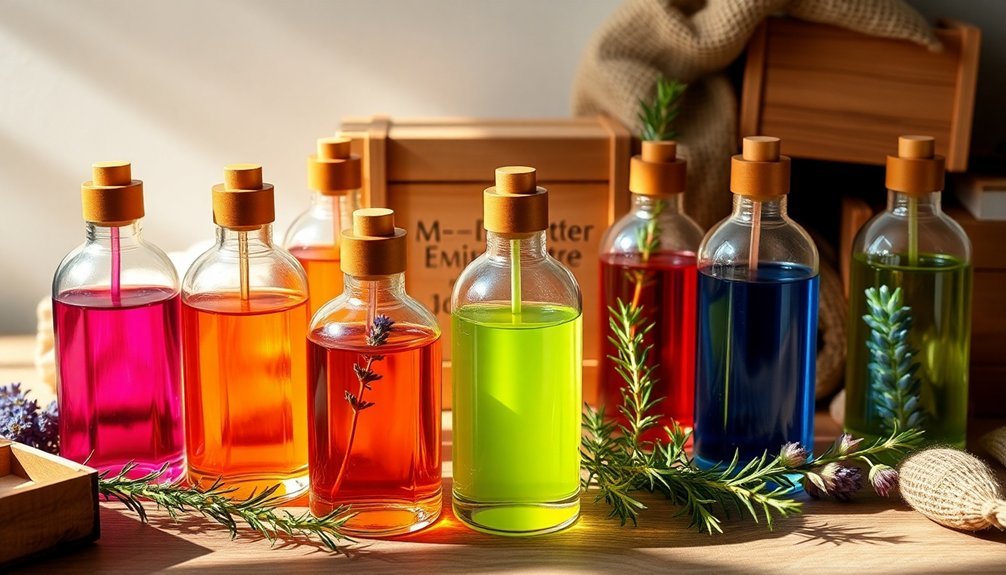
The artful creation of your woody-herbal perfume blend is just the beginning – proper storage and maturation will determine its lasting quality.
Store your perfumes in a cool, dark place between 60-70°F, away from your bathroom's humidity and fluctuating temperatures.
Keep your blends in tightly sealed, dark-colored bottles to protect them from UV rays and oxidation. You'll want to avoid direct sunlight and heat sources like windowsills or radiators.
Let your perfumes mature for 24-48 hours in their storage space, allowing the scents to meld properly.
When handling your perfumes, don't shake them vigorously. Instead, gently roll the bottle between your palms before each use.
Remember to label your creations with dates and recipes to track how they evolve over time.
Measuring and Blending Techniques
When you're making aromatherapy perfumes, you'll need to master the art of drop counting using glass droppers or orifice reducers for precise measurements.
You can start with simple dilution ratios, such as 2% (12 drops of essential oil per 1 ounce of carrier oil) for normal skin application, or 1% (6 drops per ounce) for sensitive skin.
For advanced blending, you'll want to use a graduated pipette to measure micro-quantities and maintain consistent ratios across different batch sizes.
Drop Counting Methods
Successfully creating aromatherapy perfumes requires mastering precise drop counting methods and blending techniques.
You'll need to understand how to count drops accurately using pipettes or glass droppers to achieve the right proportions in your blends.
For a 5ml bottle, you'll work with approximately 100 drops total. Here's how to allocate your drops for a light perfume:
- Start with 10 drops of base notes (like vanilla or sandalwood)
- Add 5 drops of heart notes (such as lavender or geranium)
- Include 5 drops of head notes (like bergamot or lemon)
- Fill the remaining volume with 80 drops of carrier oil
When you're experimenting, start with small batches to test your combinations.
Once you've perfected your blend, you can scale up the proportions using simple calculations while maintaining the same ratios.
Dilution Ratio Guidelines
Proper dilution ratios form the foundation of safe and effective aromatherapy blending.
When making perfumes, you'll want to start with a 1-4% dilution rate, depending on your skin's sensitivity and the oils you're using.
For normal skin, stick to a 2% dilution (2 drops per teaspoon of carrier oil). If you have sensitive skin, reduce this to 0.5-1%.
Be extra cautious with certain oils like clove bud, which requires no more than 0.5% dilution, and citrus oils like lemon, which shouldn't exceed 2% to avoid phototoxicity.
You can dilute your essential oils using several methods: carrier oils, high-proof alcohol for traditional perfumes, unscented lotions, aloe vera gel, or even solid mediums like beeswax for solid perfume bars.
Customizing Your Signature Scent
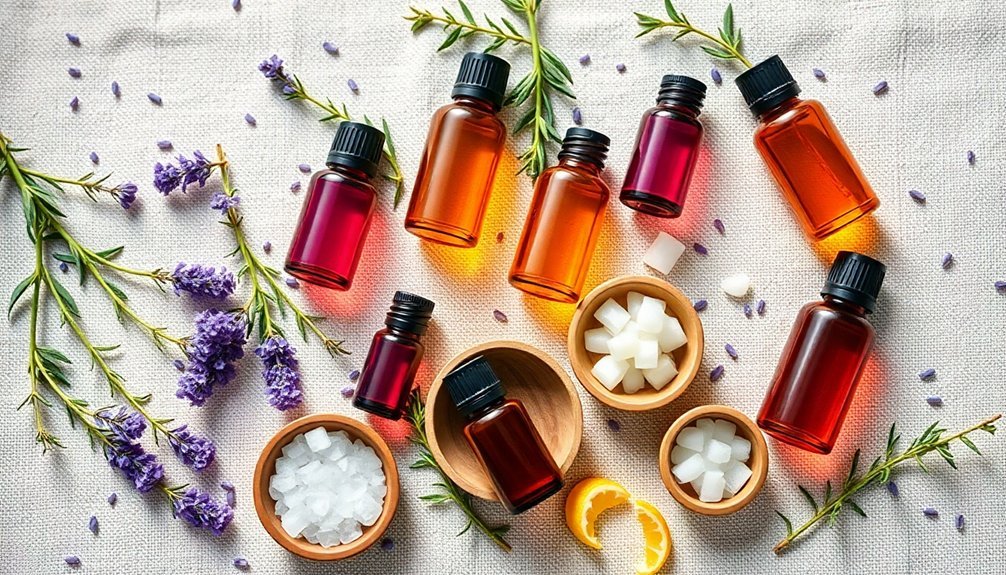
Creating a signature scent involves more than simply mixing your favorite fragrances together. You'll need to understand your fragrance preferences and how different notes work together to create a lasting impression.
Start by exploring scents that resonate with you and follow the 30/50/20 rule for a balanced blend:
- Use 30% top notes like bergamot or sweet orange for initial impact.
- Add 50% middle notes such as lavender or cinnamon for depth.
- Include 20% base notes like sandalwood or vetiver for longevity.
Test and adjust proportions until you achieve your desired result.
Remember to take into account seasonal changes and occasions when crafting your blend. You can create variations of your signature scent – a stronger version for evenings and a lighter one for daytime wear.
Always perform patch tests before applying new blends.
Natural Perfume Recipes for Stress Relief
While modern life often leaves us feeling overwhelmed, natural perfumes can provide an effective way to combat daily stress.
You'll find powerful stress-relieving properties in essential oils like bergamot, lavender, ylang ylang, and rose geranium. Each brings unique calming benefits to your custom blend.
You can create your stress-relief perfume using several methods. Try the infusion method by combining your chosen oils with a carrier oil in a roll-on bottle, or make a quick spray using sugar cane ethanol as your base.
If you prefer a more nourishing option, create a perfume balm that moisturizes while it soothes. For immediate relief, add these oils to your bath water or massage oil.
Remember to shake your blends well and store them away from direct sunlight to preserve their therapeutic properties.
Choosing the Right Carrier Oils and Bases

Selecting the right carrier oil forms the foundation of any successful aromatherapy perfume. You'll want to evaluate your skin type, desired absorption rate, and the fragrance profile you're creating when choosing your base.
For sensitive skin, jojoba and sweet almond oils offer excellent compatibility, while grapeseed oil works well for oily skin types.
When blending, follow these essential guidelines:
- Start with 15-30 drops of essential oil per ounce of carrier oil
- Allow your blend to mature for 2-3 weeks in a dark place
- Use neutral-scented carriers for strong fragrances
- Choose fast-absorbing oils for day wear, slower-absorbing for evening
If you're seeking longevity in your perfume, evaluate jojoba or fractionated coconut oil, as they help maintain fragrance integrity while providing excellent absorption.
Frequently Asked Questions
Can I Use My Regular Drinking Alcohol Instead of Perfumer's Alcohol?
You shouldn't use drinking alcohol for perfumes. It's too low in proof, won't protect your skin from essential oils, and contains additives that'll alter scents. Stick with perfumer's alcohol for safe, lasting results.
Why Does My Homemade Perfume Smell Different on Different People?
Your perfume smells different on each person because everyone's body chemistry, skin pH, and natural oils are unique. Your hormone levels, diet, and even daily activities can affect how the fragrance interacts with your skin.
How Long Will My Homemade Perfume Stay Fresh Before Going Bad?
Your homemade perfume will stay fresh for 1-2 years if you store it properly in a dark, cool place. Keep it in an airtight, opaque bottle and watch for changes in color or scent.
Can I Mix Essential Oils From Different Brands in One Perfume?
Yes, you can mix essential oils from different brands, but make certain they're pure and high-quality. Be cautious as brands may vary in concentration and purity levels, which could affect your blend's safety and effectiveness.
Will My Perfume's Scent Change if I Travel to Different Climate Zones?
Yes, your perfume will smell differently across climate zones. You'll notice stronger projection in hot weather, longer-lasting scents in humid conditions, and subtler fragrances that stick closer to your skin in cold temperatures.
In Summary
You've now got the tools and knowledge to create your own aromatherapy perfumes at home. Don't be afraid to experiment with different essential oil combinations while following the safety guidelines. Start with simple blends and work your way up to more complex formulations. Remember to keep notes of your successful recipes, and you'll soon develop your own collection of personalized, therapeutic scents.

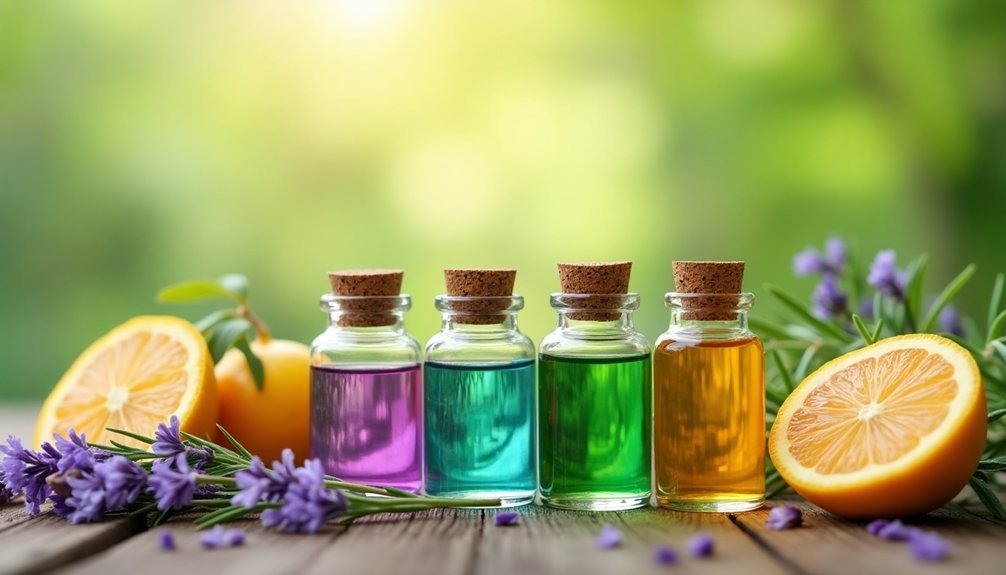



Leave a Reply